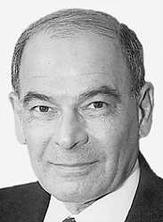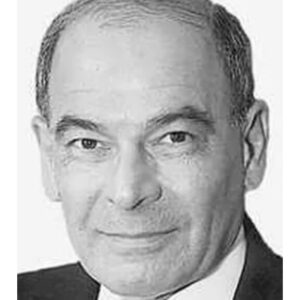
Political transitions are passages in time. They are supposed to get us from here to there. For the most part, they are orderly affairs, as structured as a Mozart sonata.
But occasionally dissonance arises out of defeat or defiance, or just plain runaway circumstances. In recent Maryland, there have been bends and bumps in the path, awkward moments and hurt feelings, but never a blatant attempt to subvert an election or the will of the voters. Here is a sampler from recent Maryland history:
It could have been the smoothest, easiest transition of administrations in modern Maryland history.
Gov. Spiro T. Agnew (R) picked up the phone, called House Speaker Marvin Mandel (D) and said: “I can resign anytime it’s convenient for you. Let me know when you want to take over.”
That was it. No muss, no fuss. That is, until Mandel was sworn in as governor on Jan. 7, 1969, and combed through the budget Agnew left behind when he departed for Washington to become vice president.

Frank A. DeFilippo
The proposed spending program was balanced — at the time not a constitutional requirement but a durable myth — by lopping 22,000 low income Marylanders off Medicaid. Mandel, angry at the deception, was handed a difficult choice — leave those citizens without health care coverage, or raise taxes to cover the $30 million the restoration would cost. He chose the latter, a daring decision during his first weeks in office.
But Agnew, as everyone knows, left a paper trail of white envelopes that led from Washington to right back where they began, the Maryland State House.
On a personal note: As a State House political reporter, I had written a story critical of Agnew’s generous salary increases for his incoming staff, among them Herb Thompson, an AP reporter and press room colleague and friend, as press secretary.
When I succeeded Thompson in the job, I found one item on the bare desk in the office on the first day I reported for work as Mandel’s press secretary. It was a copy of the article I had written about the salary increases, with the handwritten note: “Aren’t you glad he did. Good Luck, Herb.”
Agnew himself had kind of botched the hand-off from Gov. J. Millard Tawes (D) when he was sworn in as governor in 1967. Republicans had had so little time occupying the State House that they lacked a bench of experienced government hands to fill out the boxes on the executive department’s flow-chart.
Agnew’s recruitment reached far and wide — campaign aides, the State House press room, cronies, friends of friends, and a budget director from New York State. That move caused a ruckus. The New Yorker tried to impose his familiar budget procedures onto the established practices in Maryland.
The legislature rebelled. Assembly leaders established their own “legislative study group,” which produced a parallel agenda to rival Agnew’s. The Democratic Assembly prevailed, even adopted, with Agnew’s grudging support, the then-revolutionary graduated income tax system to replace the old flat-tax program.
Blair Lee 3d, Maryland’s first lieutenant governor since the Civil War, inherited a mess. He had to sanitize the battered remains of the Mandel administration as well as prepare a campaign for his own election to a full term.
In a way, Mandel simplified the job by raising taxes before stepping down, as required, upon his indictment for mail fraud and racketeering. Lee wouldn’t have to perform the distasteful deed in a campaign year as he filled out the remainder of Mandel’s elected term.
But to those around him, Lee was a reluctant candidate, more interested in the nuts and bolts of government than in the face-to-face business of campaigning.
Harry R. Hughes, his buddy from their days together in the Senate, pleaded to join Lee on his ticket as the candidate for lieutenant governor. Hughes had resigned as Mandel’s transportation secretary, claiming there had been “tampering” with the award of the contract for the Baltimore subway.
Lee was told the Mandel forces would walk away from his campaign if he chose Hughes as a running-mate. Lee, instead, settled on Steny H. Hoyer, then the state Senate president and now second in command of the House of Representatives.
Long story short: Hughes entered the race for governor and won, against all odds. Those around Lee swore he appeared relieved when he lost.
As Lee and Hughes were best buddies, there was no friction, no hard feelings. The transition was as smooth as three fingers of 30-year-old scotch. In fact, one of Hughes’ first appointments was Lee, to a coveted seat on the University of Maryland’s Board of Regents.
If Hughes had joined the Lee ticket, history might have taken a different turn. No lieutenant governor has ever won election as governor.
The hand-off from Hughes to William Donald Schaefer was, as expected, a bittersweet event. Schaefer was perpetually annoyed, as if every day he got up on the wrong side of life.
Schaefer learned in short order that his “Do It Now” commands did not go over well with the 188-member General Assembly as they had with the 19-member Baltimore City Council.
Fortunately, there was no social media in the Schaefer era.
Schaefer, as mayor of Baltimore, was still annoyed at Hughes for what he perceived as short-changing the city during his eight years as governor. Not true. Hughes was very generous to the city and, in fact, had lived in Baltimore.
What’s more, Mandel was Schaefer’s whisperer, and who knows what mischievous sayings passed from Mandel’s lips to Schaefer’s ears? Moreover, Schaefer brought with him much of that old gang of his from City Hall who were later dubbed “the Kool-Aid kids” because of their blind loyalty to Schaefer and his cyclonic whims.
But the unkindest cut of all came when Schaefer and his allegiants were planning a lavish inaugural dinner at the governor’s mansion. The mansion budget had been depleted by Hughes and his wife, Pat.
As they were preparing to depart, Hughes and his wife had spent the remaining several thousand dollars in the mansion operating fund to have their wardrobes altered to fit their reborn lives as emeritus citizens. Schaefer had to ask for an advance in the budget to pay for his coming-out party. He was annoyed.
There was no need for Schaefer to contribute to the baptism-by-bad-karma of Parris Glendening. Glendening was his own worst enemy. (But the enmity between the two would develop later, when Schaefer became comptroller. Glendening, for spite, turned off the Hilda Mae Snoops fountain that Schaefer had installed on the mansion grounds as a tribute to his long-time friend and companion. And Schaefer, in turn, outed Glendening’s affair with his staffer, Jennifer Crawford. She eventually became Glendening’s wife in what Shakespeare called a “plight troth.”)
Only after Glendening was elected governor over Republican Ellen Sauerbrey was it revealed that he and an aide, Major Riddick, had staged a raid of the pension fund in Prince George’s County where Glendening had been county executive.
They had manipulated the law to make themselves eligible for early retirement benefits and line their own pockets as they shifted from one level of government to the next. Riddick followed Glendening to Annapolis as chief of staff. After weeks of damaging publicity, Glendening repudiated the change and surrendered the financial windfall. Sauerbrey’s campaign accused the press of withholding the story until after the election.
And as if that weren’t enough, Glendening had to undergo a two-week recount of his marginal 6,000 vote win over Sauerbrey, overseen by out-of-state election sleuths. But, as the saying goes, one vote’s a victory, and two’s a landslide.
The transfer of power from Glendening to Republican Robert L. Ehrlich Jr. was one of disappointment. Glendening’s hand-picked candidate for lieutenant governor, Kathleen Kennedy Townsend, had lost to Ehrlich after a bumbled campaign and a poor performance as a candidate.
And she lost, in part, because much of the Mandel wing of the Democratic Party lined up behind Ehrlich, a frat-boy friend from his days in the House of Delegates. Ehrlich had given up a safe seat in Congress, in some measure, on that promise.
To add to the jilt, there was little faith among Democrats that Townsend had the chops to be an effective governor, which Ehrlich sensed. The airborne message at the time was that Glendening had chosen Townsend as his running-mate so he could cash in on her family name and connections as a fundraiser. She is the daughter of Robert F. Kennedy.
To be fair, Ehrlich inherited some very big bills that Glendening ran up but neglected to pay before his time was up — such as $60 million worth of new voting machines he ordered two weeks before his second term was over, the unfunded Thornton education reform bill that Glendening had signed but neglected to fund, and a tax reduction that no one expected or even thought was needed.
But even if Glendening was disappointed with the result, Ehrlich was a welcome return to the State House by his old friends and new allies — up to a point when the Second Law of Thermodynamics kicked in, which is that sooner or later everything turns to dreck. Which, for Ehrlich, it did.
For the fact is that Ehrlich brought his own pack of troubles into the governor’s office with him — administration members. One was an ice skater who became the subject of constant ridicule. Another was a forerunner to the current QAnon, Joseph Steffen, who referred to himself as “the prince of darkness” but who was merely a spreader of malicious gossip and falsehoods. Sound familiar? A third was Ehrlich’s appointments (patronage) secretary, a real estate developer named Lawrence J. Hogan Jr.
But Ehrlich’s major problem was his conversion. He left the House of Delegates for Congress as a go-along, get-along Republican and returned as governor a full-fledged Newt Gingrich “Contract with America” conservative.
Ehrlich is now practicing law and coaching his son’s football team, and Hogan is now governor and presenting himself as a possible candidate for president in 2024. Ehrlich is also now full Trump. His wife, Kendel, is a high-level appointee in the Trump administration.
Ehrlich’s turnover to Martin O’Malley was, well, not so pleasant. Ehrlich in 2006 had the unhappy stigma of becoming the first governor of Maryland not reelected to a second term since William Preston Lane in 1950.
Ehrlich and friends spent time wondering how he could have lost the election when he enjoyed a 64% favorable rating in the polls. The simple truth was that the O’Malley forces out-organized him and delivered their vote on Election Day.
And again, Ehrlich was outdone four years later, when he attempted a comeback, which landed a couple of his campaign consiglieres in deep trouble with the law and racked up another loss for Ehrlich. (Campaign robocalls were viewed as attempts to suppress the Black vote.)
O’Malley, like Schaefer, brought to the State House many of the crew that had staffed City Hall during his two terms as mayor of Baltimore. He also brought his guitar, and his Celtic-Rock band, “O’Malley’s March.”
Also tag-alongs with O’Malley to Annapolis was his signature CitiStat — the wonk’s guide to governance — which immediately morphed into State-Stat, to mimic his new status as governor.
Building on his successful liberal (or progressive, if you wish) record as governor, O’Malley’s ultimate goal of being president was crushed in 2016 when he struggled to gather support and washed out of the race almost before it got started.
Hogan learned early on that the best way to beat the Democrats in Maryland is to act like one. And, in large measure, as governor, he has.
O’Malley’s hand-off to Hogan was uneventful, if personally disappointing. O’Malley expected to pass on the governorship to his sidekick for eight years. His understudy, Lt. Gov. Anthony Brown, of Prince George’s County, had a golden resume but displayed little as a candidate to back it up.
Brown had been an up-and-comer in the legislature, an Iraqi War veteran, and a Harvard Law graduate, but the moxie somehow was missing. He failed to perform well even in his own backyard warrens, the Maryland Beltway precincts surrounding Washington, D.C.
All the while Hogan had been up to something with his nascent anti-tax political organization, “Change Maryland.” Brown had dispatched his primary challengers easily enough, although the early warnings were apparent.
But come the general election, his weaknesses began to show — among them O’Malley fatigue. All the Democratic heavyweights came to Brown’s rescue but couldn’t save him — Barack and Michelle Obama and Hillary Clinton. The Democratic Governors Association, which was headed by O’Malley, poured $1 million into Maryland on Brown’s behalf.
And now Brown is a member of Congress and is being mentioned as a possible candidate for governor again in 2022.
And Hogan, as did O’Malley, is selling himself through his ubiquitous presence on television as a potential candidate for president in 2024.
Plus ca change.




 Creative Commons Attribution
Creative Commons Attribution